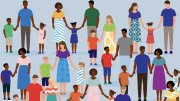The problem: There’s a “skills gap” in the American workforce. Employers searching for skilled candidates can’t find them—even as candidates applying to hundreds of jobs can’t get hired. The diagnosis: an underperforming partnership between community college educators and employers.
According to a new report from Harvard Business School’s Project on Managing the Future of Work (MFW), a disconnect between educators and employers is harming America’s workforce. The report comes from MFW program director Manjari Raman and professor of management practice Joe Fuller, MFW program leader and co-director of the Project on Workforce (a joint program with Harvard Kennedy School, Graduate School of Education, and HBS, profiled by the Magazine here).
Community colleges are one of the best, most affordable places for Americans to train for what the report calls “middle-skill” jobs: positions that require more than a high-school diploma but less than a bachelor’s degree, pay wages of more than $45,000 a year, and offer room for upward mobility. They are also in a prime position to design curricula focused on the skillsets local employers seek, to ensure their students are employable after graduation. Currently, however, this type of employer/educator collaboration is not happening often enough, or effectively enough.
The Harvard team worked with the American Association of Community Colleges to measure the state of this collaboration, collecting survey data from more than one-quarter of American community college leaders and 347 of the nation’s business leaders. The data underscore the disconnect and offers employers and educators a 51-item “partnership playbook” to improve their relationship on students’ (and employers’) behalf.
Findings include:
- 93 percent of educators gave employers a “B” grade or lower on their level of collaboration with community colleges. Meanwhile, two-thirds of employers gave themselves a grade of “A” or “B.”
- 80 percent of educators believed their community college produced work-ready graduates, but only 62 percent of employers agreed.
- Only 11 percent of educators said their local employers agreed to set hiring targets and only 10 percent reported employers would guarantee jobs to students who completed certain training programs.
- 47 percent of employers believed it was more cost-effective to hire talent on the open market, rather than training new talent.
- Only one in four employers said they openly communicated their hiring needs to educators. More than 50 percent of business leaders weren’t sure what skills they would prioritize in hiring.
“The current state of collaboration is failing to meet today’s business needs and putting future competitiveness and prosperity at risk,” Fuller said in a news announcement about the report. But effective partnership is possible, he says, and in the near term. For instance, employers can attend community college job fairs and offer company site visits for interested students; community colleges can discuss needed skill sets with employers when designing curricula and could hire industry experts to teach courses. Actions like these support the report’s recommendations:
- Partner with each other to offer training and education aligned with industry needs.
- Establish relationships with each other that result in the recruitment and hiring of students and graduates.
- Make supply and demand decisions that are informed by the latest data and trends.
“Businesses need to take the lead in any such [collaborative] effort, given their control over the most relevant currency in this market: jobs,” the report states. Co-author Raman added, “It’s in businesses’ best interest to initiate [community college] partnerships to ensure they get the workforce-ready talent they need—as well as help students access jobs with decent wages.”
To learn more about Harvard research on community colleges and the skills gap, and to read profiles of community college students, see Harvard Magazine’s May-June 2022 feature, “The Upward Mobility Problem.”








